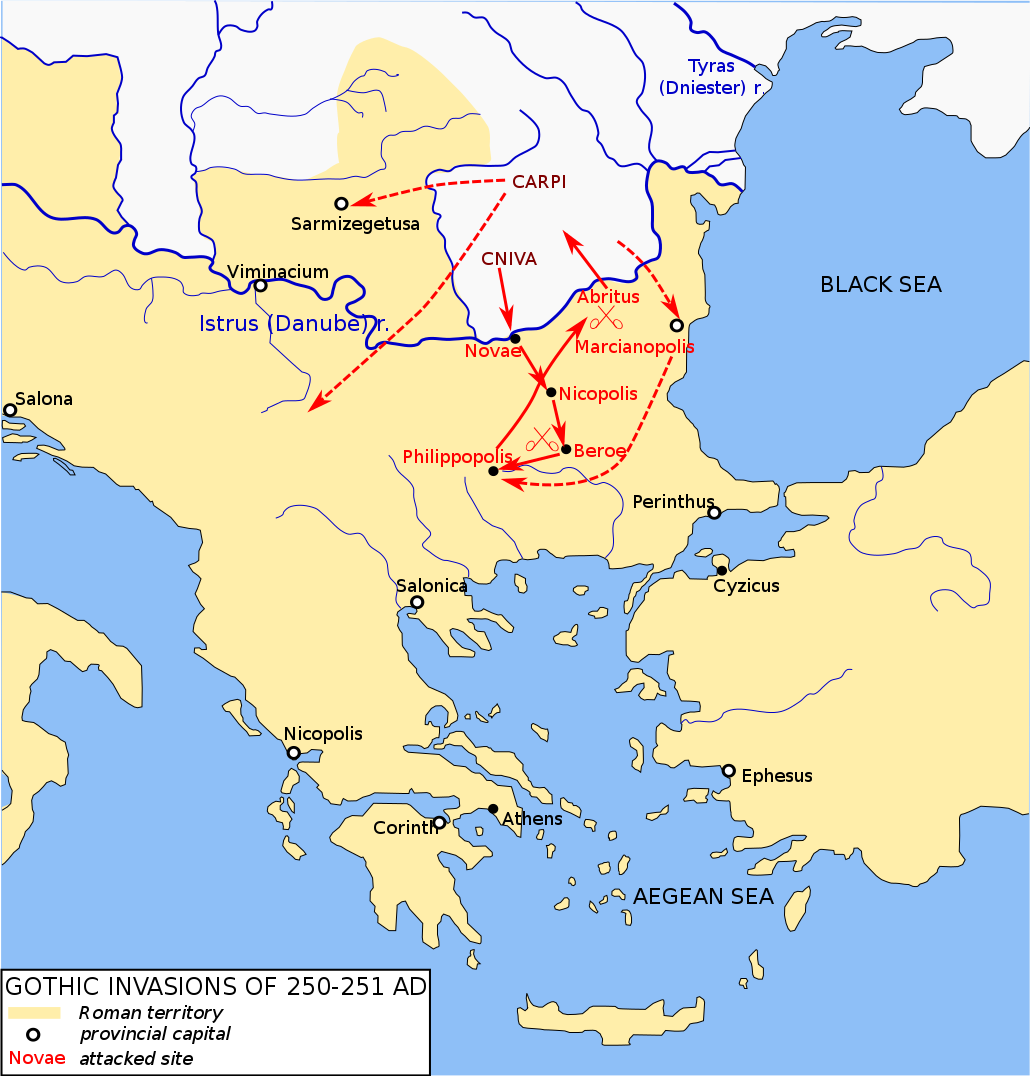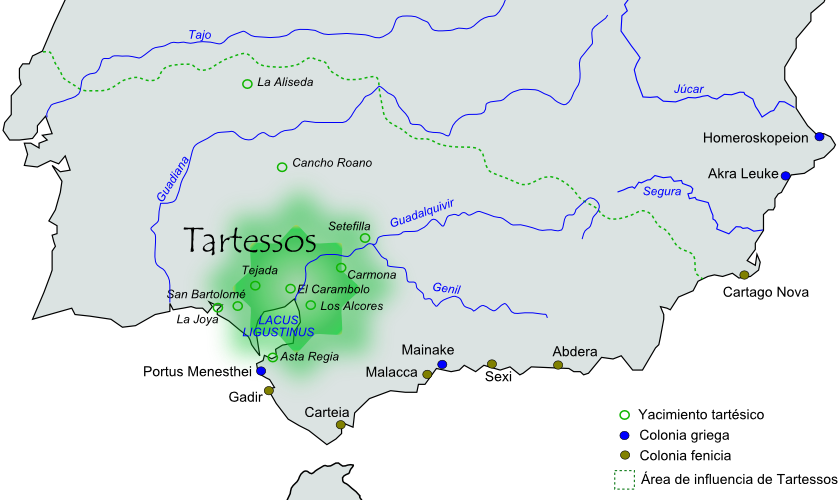1. THE REPUBLIC.
1. 1. Cronology.
We can distinguish three phases in the history of the roman civilization:- Monarchy from 753 B. C. to 509 B. C.
- Republic from 509 B. C. to 30 B. C.
- Empire from 30 B. C. to 476 A. D.
2. Los orígenes de la ciuda.
In the first millnium B.C. the Italian Peninsula was inhabited by different peoples:
- etruscos en el norte;
- griegos en el sur;
- y sabinos, latinos, samnitas en el centro.
2. 1. Los orígenes míticos.
Los romanos sintieron la necesidad de darle un origen mítico a su ciudad:
- El poeta Virgilio escribió la Eneida en el siglo I a. c., en la que se afirmaba que el origen de Roma, estaba en Eneas, un semidiós troyano, hijo de la diosa Venus, que decidió establecerse en el Lacio después de la caída de Troya.
- Según la leyenda, años más tarde, Rea Silvia, una descendiente de Eneas, tuvo dos hijos con el dios Marte: Rómulo y Remo, que fueron abandonados en el río Tiber. Los gemelos fueron amamantados por una loba y al crecer fundaron Roma, pero se pelearon y Rómulo mato a Remo, convirtiéndose en el primer rey de la ciudad.

Archeological remains show that:
- in the 8th century BC, some latin tribes came together on top of the Palatine Hill on the bank of the River Tiber, a place that was easy to defend and well communicated.
- In the 7th century BC, the latins occupied the seven hills around the River Tiber to protect themshelves from their enemies.

- There were seven kings in Rome, the firsts four latin, the last three Etruscan (who occupied Latium).
- Los reyes tenían todos los poderes: administraba justicia, dirigía el ejercito y era el sumo sacerdote. Gobernaba con el Senado, una asamblea formada por miembros de las grandes familias aristocráticas.
- La economía era agrícola y ganadera, pero el comercio y la artesanía también eran muy importantes.
2. REPUBLICAN ROME, (6th to 1st century BC).
OrigIn: in 509 BC, the aristocratic families of Rome with the help of the people, ended the reign of the last Etruscan king, Tarquinius Superbus and Rome became a Republic.2. 1. The fight for citizenship.
Casuse: In Rome there were two main social groups:- the patricians were a minority of aristocratic families (genes) who:
- made laws.
- exercised justice.
- monopolised public positions.
- the plebeians, who were the majority of the population (peasants, artisans, traders). They had no political rights, buy had to paid taxes and join the army.
The plebeians fought for the same right as patricians for 200 years. By the 3rd they became roman citizes and obtained:
- The right to chose a representative to defend their interest: the plebeian tribune..
- A set of public writing laws: the Law of the Twelve Tables.
- The right to marry patricians and to hold public poistions.
2. The republican goverment.
Roma era una oligarquía, tenían más poder los ciudadanos más ricos y los pobres no tenían acceso a las magistraturas..
There were three main institutions:
- The senate, composed of 300 former magistrates. Was in charge of:
- foreing policy and finances.
- ratify the laws pass in the assemblies.
- The magistrates who ruled in the name of the Senate and the people of Rome. There were two types:
- Superiors: cónsuls (ran the goverment and the army), pretors (justice) and censors (appointed the senators).
- Inferiors: aediles (ran the city), cuestors (collected taxes) and pebleian tribuen (cuold oppose the decisions of other magistrates).
- The assemblies were made of up of citizens who voted for laws and electred magistrates. There were three types:
- century assemby:
- divided citizens into 193 different groups according to wealth. The richs had most of the votes.
- elected supperior magistrates.
- tribal assembly:
- divided citizens according to residence.
- elected inferior magistrates and the pebleian tribune.
- curiate assembly:
- did not have a political role.
3. The territorial expansion and the crisis of the Republic.
3. 1. Phase of the territorial expanion.
The Roman Republic expanded in several phases:- From 500 to 250 BC it conquered the Italian Peninsula.
- From 264 to 164 BC y II a. c, it conquered the Western Mediterranean.
- From 2nd century BC to 1st centuriy AD, a. c. y I d. c. conquered the eastern Mediterranean, Gallia, Britannia and a part of Central Europe.
3. 2. The Roman army.
The Roman army was composed of all citizens between the ages of 17 and 60.The basic military unit was the legion, whic was made up of 5.00 men.
Legionaries stayed in camps which were like small towns and often became the origin of cities.
3. 3. The crisis od the Republic.
The conequest created numerous problems:- Social inequalities. Some people became rich from the profit of war, the selling of prisoners and the explotation of large estates (latinfundia).
- Social crisis. Many peasants lost their lands because they had to serve in the army. This provoked revolts, such as the one led by the Gracchi brothes (2nd century BC).
- The Senate gave power to military commanders (dictators) to stop the revolts, but they began fighting each other, causing civil wars.
3. 4. Julius Caesar.
Julius Caesar was elected consul in 59 BC, and governor of several provinces the next year.He managed to conquer the Galia and with the support of the pebleians he became dictator in perpetuity in 44 BC.
Some senators though that he wante to become a king with the support of the plebeians and killed him in 44 BC.
 |
| Rome in 264 B. C. |
 |
| https://commons.wikimedia.org/wiki/User:Dzlinker https://upload.wikimedia.org/wikipedia/commons/3/35/Egypt%2C_Rome%2C_Carthage_and_Numidia.jpg |
 | |
| https://commons.wikimedia.org/wiki/File:Roman_Republic-44BC.png
https://commons.wikimedia.org/w/index.php?title=User:Clip~commonswiki&action=edit&redlink=1 ROMAN REPUBLIC IN 45 BC. |
 |
| Roman republic 30 B. C. |
The expansion of the Roman Empire.
4. THE ROMAN EMPIRE (1st century BC to 5th CENTURY AD).
After Caesar's death, his adopted son Octavius won a civil war. He established a new form of goverment:
- In 27 BC, the Senate named him Augustus (chosen by the gods).
- he was the head of the army: Emperor.
- most senior religious authority: Pontifex Maxinus.
- He had all the powers: consul, passed the laws and appointed the Senate and the Assemblies.
4. 2. The imperial cult.
When Augustus died, he was deified, starting the imperial cult. Romans were allowed to practise various religions but the Imperial Cult was obligatory to show that people were loyal to Rome.4. 3. A period of prosperity (1st to 2nd century AD).
The 1st and 2nd centuries AD were a Golden Age for the Empire known as the Pax Romana, for 200, the Roman empire controlled a vast an peaceful territory due to:- a powerful army protected the borders (limites) from attacks by barbarians using walls.
- the integration of the of the ocnquered peoples into Roman culture due to the road network, the economic prosperity, the growth of cities and the spread of the Latin language: romanization.
4. 4. Control of the territory.
The Empire was divided into provinces, which were ruled by a governor, elected by the senate or the emperor, and assisted by oficials. The governors were in charge of:- collect taxes.
- judge crimes.
- look after the cities.
 |
| Hadrian's Wall ruins, built to protect the Northern frontier of the Roman Britian. |
3. 3. Romanization:
5. ROME.
Rome the capital city of the Roman empire was the biggest time of Antiquity with about a million inhabitants, most of them lived in crowned apartamente buildings (insulae).In the center of the city, built around seven hills, were located the most important buildings:
- temples
- baths, complexes for personal hygiene and sports, with an open-air space for physical exercise and cold, warm and hot water pools for bathin.
- circus for chariots races.
- amphiteathre for gladiator fights.
- theather.
6. THE ROMAN SOCIETY.
6. 1. Citizens: the rich and the poors.
From the 3th century AD, most of the free men were citizens. They had political rights and were protected by laws,but they were divided according to their wealth:- the nobles were senators, senior empire officials, rich plebeians with businesses and middle managers (equites).
- Plebeians were the large masses of pesants and salaierd ubran dwellers. Many of them lifec on money and the amusements given by the State (bread and circuses).
6. 2. Women in Rome.
Roman women had limited rights and could not participate in politics. Families were patriarchal and the the pater familias had authority over his wive and childrens:- higher-class women had their own fortunes and could manage propierty.
- poorest women worked on land, in workshops and domestic service.
6. 3. Slaves and freemen.
Slaves made up a half of the population of Rome. They did the mos difficult work, but also were teachers and administrators.A slave could be freed and obtained Roman citizenship: libertos or freedmen.
6. 4. An urban society.
Roman society were based in cities. Roman cities were:- were home of the goverment.
- were economic centres: artisanship and trade.
- were surrounded by walls.
- had a central square, the forum, which was the centre of political and religious life.
8. THE FALL OF THE EMPIRE.
The Roman Empire entered 8. a serious crisis from the 3nd century AD onwards.In the 5th century, the Empire broke up and the western part was conquered by Germanic peoples.
8. 1. The start of the crisis.
In the 3rd century the Empire experienced a crsis:
- The territorial expansion stopped and the germanic people beyond the borders attacked the borders.
- Economic crisis due to:
- lack of slaves.
- reduction of the agricultural production.
- stop of trade due to the barbarian attacks.
- Revolts and assassination of, because the army was the only authority in the provinces.
8. 3. Christianity: the religion of the empire.
- Between the 1st and 3rd centuries AD, the Christians were persecuted and tortured because they refused to follow the impeiral cult.
- From the 3rd century D, Christianity spreaded through the Empire as a result of the social crisis.
- 313 AD, Emperor Constantine made Christianity legal (Edict of Milan).
- At the end of the 4th century, Theodosius declared it the official religion.
8. 4. The fall of the Western Roman Empire.
In the 395 AD, the Empreor Theodosius divided the Empire into two parts, two make easier to defend:- Eastern Roman Empire, ruled by Arcadio, was the richest and most populous.
- Western Roman Empire, ruled by Honorio, was the poorest part.
In 476 AD, Odoacer, a barbarian chief, removed the last roman empero, Romulus Ausgustus from power.
 |
MAP OF THE GOTHIC INVASIONS DURING THE THIRD CENTURY.File:GothicInvasions250-251-en.svg https://commons.wikimedia.org/wiki/User:Dipa1965 |
 |
Division of the empire by Theodosius I, 395 AD. Licencia: Dominio Público. |
 |
| File:Invasions_of_the_Roman_Empire_1.png User:MapMaster License: (CC BY-SA 2.5) |




.jpg)





